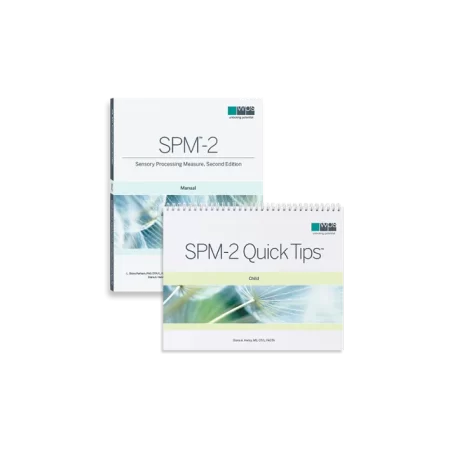
Sensory Processing Measure, Second Edition and SPM-2 Quick Tips™ spm-2
For: Provides a complete picture of sensory integration and processing difficulties in multiple environments; SPM-2 Quick Tips offer item level intervention strategies to help with sensory integration and processing challenges
Norms: Based on 3,850 typically developing participants, ranging in age from 4 months to 87 years
Scores: Raw scores, standard scores (T-scores), percentile scores, DIF scores
Format: Rating scales completed by various raters in examinee’s life
Admin Time: 20 to 30 minutes for each of the 12 main forms; 10 minutes for each Environment Form
Ages: 4 months to 87 years - Infant/Toddler (4 to 30 months) / Preschool (2 to 5 years) / Child (5 to 12 years) / Adolescent (12 to 21 years) / Adult (21 to 87 years)
Published: 2021
Authors: L. Diane Parham, PhD, OTR/L, FAOTA, Cheryl L. Ecker, MA, OTR/L, Heather Kuhaneck, PhD, OTR/L, FAOTA, Diana A. Henry, MS, OT/L, FAOTA, Tara J. Glennon, EdD, OTR/L, FAOTA
To learn more about which SPM-2 kit or product will suit your needs the best, please click here.
Printed Manuals
Click to browse products
Online Forms, Reports, Kits & e-Manuals
Click to browse products
Printed Forms & Handscoring Materials
Test forms, response booklets and scoring reference manuals.
Printed Kits
Click to browse products
SPM-2 Child Online Quick Tips
SPM-2 Child Print Quick Tips
SPM-2 Online Manual
SPM-2 Preschool Online Quick Tips
SPM-2 Preschool Print Quick Tips
SPM-2 Print Manual
SPM-2 Adolescent Home Online Form (25 Uses)
SPM-2 Adolescent Home Online Form (5 Uses)
SPM-2 Adolescent School Online Form (25 Uses)
SPM-2 Adolescent School Online Form (5 Uses)
SPM-2 Adolescent Self-Report Online Form (25 Uses)
SPM-2 Adolescent Self-Report Online Form (5 Uses)
SPM-2 Adult Rater Report Online Form (25 Uses)
SPM-2 Adult Rater Report Online Form (5 Uses)
SPM-2 Adult Self-Report Online Form (25 Uses)
SPM-2 Adult Self-Report Online Form (5 Uses)
SPM-2 Child Home Online Form (25 Uses)
SPM-2 Child Home Online Form (5 Uses)
SPM-2 Child School Online Form (25 Uses)
SPM-2 Child School Online Form (5 Uses)
SPM-2 Infant Online Form (25 Uses)
SPM-2 Infant Online Form (5 Uses)
SPM-2 Infant/Toddler Caregiver Self-Report Online Form (25 Uses)
SPM-2 Infant/Toddler Caregiver Self-Report Online Form (5 Uses)
SPM-2 Preschool Home Online Form (25 Uses)
SPM-2 Preschool Home Online Form (5 Uses)
SPM-2 Preschool School Online Form (25 Uses)
SPM-2 Preschool School Online Form (5 Uses)
SPM-2 Toddler Online Form (25 Uses)
SPM-2 Toddler Online Form (5 Uses)
SPM-2 Adolescent Home Print Form (Pack of 25)
SPM-2 Adolescent School Print Form (Pack of 25)
SPM-2 Adolescent Self-Report Print Form (Pack of 25)
SPM-2 Adult Rater Report Print Form (Pack of 25)
SPM-2 Adult Self-Report Print Form (Pack of 25)
SPM-2 Child Home Print Form (Pack of 25)
SPM-2 Child School Print Form (Pack of 25)
SPM-2 Infant Print Form (Pack of 25)
SPM-2 Infant/Toddler Caregiver Self-Report Print Form (Pack of 25)
SPM-2 Preschool Home Print Form (Pack of 25)
SPM-2 Preschool School Print Form (Pack of 25)
SPM-2 Toddler Print Form (Pack of 25)
SPM-2 Adolescent Online Kit
SPM-2 Adolescent Print Kit
SPM-2 Adult Online Kit
SPM-2 Adult Print Kit
SPM-2 Child Online Kit with Quick Tips
SPM-2 Child Print Kit with Quick Tips
SPM-2 Infant/Toddler Online Kit
SPM-2 Infant/Toddler Print Kit
SPM-2 Preschool Online Kit with Quick Tips
SPM-2 Preschool Print Kit with Quick Tips
Contact PAA today to establish a WPS Online Evaluation System account for online administration, scoring and reporting.
Self-Regulation and Coping Across the Life Span Using the Sensory Processing Measure, Second Edition
RECORDED WEBINAR
Duration: 60 minutes
Watch now
Behind the Scenes of the SPM-2 Assessment & SPM-2 Quick Tips: Sensory Integration and Processing Across the Lifespan
AUTHOR PANEL DISCUSSION
Duration: 60 minutes
SPMTM-2 and SPM-2 Quick TipsTM Case Study
What’s behind Johnny’s behavioural challenges in class?
Music class rattled Johnny. The sounds disorganized his thoughts. During lunch in the cafeteria, the noises were downright painful. In the classroom, he constantly fell out of his seat. Even in PE class, which Johnny enjoyed, he needed to separate himself from his classmates and press his body against the wall to feel better.
As a punishment for his behaviour, his teacher took away his recess time and repeatedly sent him to the principal’s office.
They didn’t know Johnny had sensory processing issues. When they eventually understood what he was dealing with, they made some simple changes that redirected Johnny’s life for the better. Johnny’s experience also taught the teachers how similar changes to the large classroom environment could benefit so many more students.
About This Product
SPM-2™: Expanded Across the Lifespan for Research, Clinical, and School-Based Practice
You can’t see sensory processing deficits just by looking at someone, but their needs will become clearer when you use the new SPM-2.
The SPM-2 is an upgrade and expansion of the Sensory Processing Measure family of products, widely acclaimed as the best of its kind. A behaviour rating scale, the SPM-2 offers new forms – including driving forms – and a broadened age range, so no one gets left behind.
Like its predecessors, the new SPM-2 is firmly grounded in Ayres Sensory Integration® theory. T‑scores provide norm-referenced indexes of the integrative functions of praxis and social participation, as well as the following sensory systems:
Visual
Auditory
Tactile
Olfactory and Gustatory (new)
Proprioceptive
Vestibular
The SPM‑2 items provide descriptive clinical information on processing vulnerabilities within each sensory system, including under- and over-reactivity, sensory-seeking behavior, and difficulties with perception.
The forms at each age level are designed for maximum flexibility in choosing and comparing among environments and raters, such as multiple caregivers.
What’s new in the SPM-2
The SPM-2 is a revision and update of the Sensory Processing Measure and Sensory Processing Measure–Preschool, two well-established instruments in wide use throughout the world. While the essential characteristics of the SPM and SPM-P remain unchanged, the SPM-2 revision includes the following improvements:
An expanded age range that encompasses the lifespan, from 4 months to 87 years
New and revised forms across five age levels: Infant/Toddler, Preschool, Child, Adolescent, and Adult
Updated norms based on a new, nationally representative standardization sample
Ability to compare sensory integration and processing function between individuals
New clinical validity studies, including sensory processing disorders, autism spectrum disorders, speech–language pathologies, intellectual and developmental disorders, attention-deficit/hyperactivity disorder, and other mental health disorders
Updated SPM-2 Quick Tips now included in every Preschool and Child kit
Print or online administration
The SPM-2 may be administered using printed forms or electronically through the WPS® Online Evaluation System™ (OES), the WPS online testing platform, which allows administration of the SPM-2 on any computer with Internet access. Raters may complete the SPM-2 form remotely or on the professional’s local device. When administered to the same rater multiple times, the form can be scored and integrated into a Progress Monitoring Report. Multiple forms on the same client can be scored and integrated into a combined report. For more information, click here.
Multiple raters, integrated assessment
The SPM-2 is designed to assess clients across the life span, with unique forms in each of five age levels: Infant/Toddler, Preschool, Child, Adolescent, and Adult. At each level, forms may be used independently or jointly to provide an overview of a client’s sensory functioning across multiple environments and raters.
The 12 main forms each consist of 80 Likert-type items rated in terms of the frequency of a specific behaviour (Never, Occasionally, Frequently, Always) and require about 20 to 30 minutes to complete. The 10 School Environment and Driving Environment Forms are 15 to 18 items each and take about 10 minutes to complete. The following SPM-2 forms are listed by age level:
Infant/Toddler (4 to 30 months)
Parents and caregivers rate an infant or toddler and also rate themselves on their own sensory integration and processing function.
Infant Form
Toddler Form
Caregiver Self‑Report Form
Preschool (2 to 5 years)
Parents, caregivers, and school providers rate a preschool-aged child within the home and school environments.
Home Form
School Form
Child (5 to 12 years)
Parents, caregivers, and school staff rate a school-aged child within the home and school environments.
Home Form
School Form
School Environment Forms
Art (ART) Form
School Bus (BUS) Form
Cafeteria (CAF) Form
Music (MUS) Form
Physical Education (PHY) Form
Recess/Playground (REC) Form
Adolescent (12 to 21 years)
Adolescents rate themselves, and parents, caregivers, and school staff rate the adolescent within the home and school environments.
Home Form
School Form
Self‑Report Form
Adolescent Driving Environment Forms
Adult (21 to 87 years)
Adults rate themselves, and spouses, partners, parents, other adult family members, or caregivers rate the adult within the home and community environments.
Rater Report Form
Self‑Report Form
Adult Driving Environment Forms
The SPM‑2 forms are intended to be used together as an integrated system to provide a comprehensive overview of a client’s sensory integration and processing across home, school, caregiving, and community settings. As such, multiple forms may be used within each age level. However, each form may also be used separately.
Comprehensive and easy to understand
The SPM-2 provides information in a way that parents find useful. Scale names remain comprehensible, results are summarized visually, and interpretation is clear-cut. These features help therapists explain assessment results and engage parents in the treatment process.
The main forms include each of the following scales:
Vision
Hearing
Touch
Taste and Smell
Body Awareness
Balance and Motion
Sensory Total
Planning and Ideas
Social Participation
SPM-2 Scores
SPM‑2 items employ a rating scale based on how frequently behaviors occur.
SPM‑2 raw scores for each of these scales are converted into normalized T‑scores, a type of standard score, which have a mean of 50 and a standard deviation of 10. A standard score enables an individual’s test results to be compared with a reference group, such as a normative sample of typically developing individuals. A standard score also allows for comparison of scores across scales with different characteristics, such as different numbers of items, different psychometric properties, or different constructs.
SPM‑2 T-scores are used in conjunction with an analysis of item responses to develop an interpretation of a client’s functioning.
SPM‑2 T-scores are also used to calculate the Difference (DIF) score, which allows clinicians to compare sensory functioning across any two forms. A DIF score can reveal, for example, whether a child’s behaviour at home is markedly different from their behaviour at school, or whether an adolescent’s self-perception is substantially different from a teacher or parent’s perceptions. It can also provide a starting point for examining sensory integration and processing differences between individuals; for example, between two spouses or a parent and child.
Psychometrically strong
The SPM‑2 was standardized on 3,850 typically developing participants, ranging in age from 4 months to 87 years. Separate demographically representative normative samples were collected for each age level: Infant/Toddler (N = 697), Preschool (N = 606), Child (N = 840), Adolescent (N = 985), and Adult (N = 722). Separate norms are provided for each age level, and within two age levels (Infant/Toddler and Preschool), the norms are further stratified by age to control for developmental differences between the younger and older children. A separate sample of 639 participants receiving clinical services was used to verify that the SPM‑2 differentiates between typically developing participants and those with certain clinical disorders.
Across all forms, the SPM‑2 showed strong psychometric properties. Evidence supporting reliability included median estimates of internal consistency of .86, test–retest reliability of .84, alternate-forms reliability of .78, and interrater reliability of .66. Likewise, comprehensive development procedures, concurrent administration of key measures, and findings from clinical groups yielded evidence supporting content validity, construct validity, and criterion-related validity.
Use with confidence
The SPM‑2 forms perform well on seven key indexes of reliability: internal consistency, test–retest reliability, standard error of measurement, interrater reliability, alternate-forms reliability, cross-rater concordance, and digital and paper forms equivalence. Analyses of content and structure support the scoring of separate sensory systems, praxis, and social participation scores across the SPM‑2 forms. The SPM‑2 forms correlate in expected ways with two measures of sensory integration and processing, the Sensory Profile and the Sensory Profile 2, and a measure of adaptive behaviour, the ABAS‑3. Finally, the SPM‑2 forms distinguish between typically developing and clinic-referred clients, with robust and clinically meaningful effect sizes.
Principles of use
The SPM‑2 is intended to support the identification and treatment of those with sensory integration and processing difficulties. The SPM‑2 was developed by occupational therapists, but the information it provides will also be of value to other professionals, including school psychologists, clinical psychologists, social workers, counselors, physical therapists, speech–language pathologists, early intervention specialists, psychiatrists, paediatricians, and nurses.
The SPM‑2 may be used alone as a screening instrument or in conjunction with other instruments as part of a comprehensive battery. Like any instrument, however, the SPM‑2 should never be used in isolation to make diagnostic or treatment decisions. Instead, it should be used in concert with other data, such as information derived from concurrent or former assessments of sensorimotor function; additional standardized assessment instruments; developmental, school, work, or medical records; occupational profiles; direct observations; and interviews with parents, teachers, school staff members, and (when appropriate) the client.
Intervention: SPM-2 Quick Tips
After administering the SPM-2, the assessment will guide you to appropriate intervention strategies in the SPM-2 Quick Tips, which are currently available at the Preschool and Child age levels.
The SPM‑2 Quick Tips are simple, straightforward suggestions, tasks, and activities connected to each SPM‑2 item, designed to help clients manage, minimize, or cope with sensory integration and processing challenges. The SPM‑2 Quick Tips make use of Ayres Sensory Integration principles and specific sensory techniques and are meant to be implemented by various people involved in a client’s care, including parents, day care providers, teachers or other school personnel, early intervention providers, adult caregivers, occupational therapy practitioners, and mental health experts.
Every SPM‑2 Quick Tips suggestion is designed to further one of the seven objectives listed below. Using clinical reasoning, the practitioner and team choose or develop strategies that most closely align with one or more of these objectives:
Improve sensorimotor functions
Educate to support functioning
Promote self-advocacy and empowerment
Develop adaptations and accommodations
Use cognitive or behavioural strategies
Teach new skills, including self-regulation
Address the sensory integration and sensory processing patterns of others
Like the SPM-2, the Quick Tips are available in print or online, allowing you to measure qualitative and quantitative progress. The online module on the OES allows you to quickly create customized intervention reports that can be easily shared via email or printed paper.
You can choose and track the frequency of use of each strategy within their own environment using the SPM-2 Quick Tips Record Form, available in printed version and online. The SPM-2 Quick Tips Record Form, which automatically calculates the weekly and monthly totals, can be used for research and to monitor progress.
NB: Prices are in Australian dollars inclusive of GST. NZ customers need to log in to view ex-GST prices.



